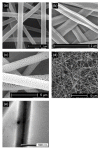Bio-Based Electrospun Fibers for Wound Healing
- PMID: 32971968
- PMCID: PMC7563280
- DOI: 10.3390/jfb11030067
Bio-Based Electrospun Fibers for Wound Healing
Abstract
Being designated to protect other tissues, skin is the first and largest human body organ to be injured and for this reason, it is accredited with a high capacity for self-repairing. However, in the case of profound lesions or large surface loss, the natural wound healing process may be ineffective or insufficient, leading to detrimental and painful conditions that require repair adjuvants and tissue substitutes. In addition to the conventional wound care options, biodegradable polymers, both synthetic and biologic origin, are gaining increased importance for their high biocompatibility, biodegradation, and bioactive properties, such as antimicrobial, immunomodulatory, cell proliferative, and angiogenic. To create a microenvironment suitable for the healing process, a key property is the ability of a polymer to be spun into submicrometric fibers (e.g., via electrospinning), since they mimic the fibrous extracellular matrix and can support neo- tissue growth. A number of biodegradable polymers used in the biomedical sector comply with the definition of bio-based polymers (known also as biopolymers), which are recently being used in other industrial sectors for reducing the material and energy impact on the environment, as they are derived from renewable biological resources. In this review, after a description of the fundamental concepts of wound healing, with emphasis on advanced wound dressings, the recent developments of bio-based natural and synthetic electrospun structures for efficient wound healing applications are highlighted and discussed. This review aims to improve awareness on the use of bio-based polymers in medical devices.
Keywords: biodegradable; biopolymers; nanofiber; skin; tissue engineering; wound dressing.
Conflict of interest statement
The authors declare no conflict of interest.
Figures









References
-
- Chen Q., Wu J., Liu Y., Li Y., Zhang C., Qi W., Yeung K.W.K., Wong T.M., Zhao X., Pan H. Electrospun chitosan/PVA/bioglass Nanofibrous membrane with spatially designed structure for accelerating chronic wound healing. Mater. Sci. Eng. C Mater. Biol. Appl. 2019;105:110083. doi: 10.1016/j.msec.2019.110083. - DOI - PubMed
Publication types
Grants and funding
LinkOut - more resources
Full Text Sources

